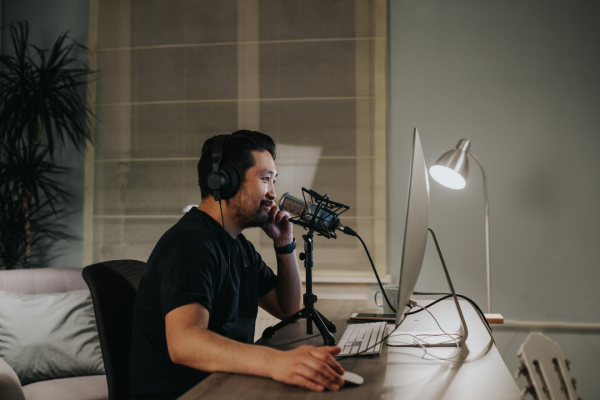Online presentations are part of our everyday lives. It doesn’t matter if you’re planning to do a training session, a product launch, or a demo in front of a live audience. Nowadays, if you want to reach your target audience, you need to present online.
But you can’t just improvise and say whatever comes to mind in front of the camera. Even if you’re not in the same venue as your audience, you need to follow a script to help ensure that you reach your live presentation goals and keep on track while you’re presenting so you don’t miss any important points.
So, how can you create a script for live webinars?
3 Key Points To Consider Before You Start Writing the Webinar Script
There are three questions you need to ask yourself before you set out to write your webinar script. The answers to these questions will determine your script and the overall flow of your live video webinar.
Question #1 – Does the topic have value?
The topic of the webinar must be relevant to your audience. That’s a no-brainer. Here are two ways to come up with relevant topics for a webinar.
Consider your competition
Your competitors are going to have a similar audience to your own, so it may just be a good idea to take a look at what topics they’re covering to start compiling a list of your own.
Eventbrite is also a great resource for finding topics. Just go to the website and scroll through the list of events — both offline and online. Interesting events will generally have a high attendance and can give you great insight into what might work for you in a live webinar environment.
Source: Eventbrite
Create a list of topics that people find interesting. Then, use these insights as inspiration for coming up with a live webinar that will resonate with your audience.
Ask for suggestions
The second option is to ask your audience for input. There are many ways you can do this from sending an email survey to hosting a live Q+A to polling a Facebook group. Feedback from your audience can help you come up with some original live webinar ideas.
What is your key takeaway?
All webinars are online presentations. That doesn’t mean, however, that all organizers have the same goal for running a live webinar. Maybe the goal is to get the audience to purchase your product or service? Or perhaps it’s just to increase awareness about your business?
Your goal or goals will determine how you should write your script for your audience.
For example, if your goal is to sell a product or service, you have to show the benefits. If your goal is to increase awareness about your product’s new features, your key takeaway should be around how the new features will benefit your target audience.
What is the knowledge level of your audience?
Before you start creating your webinar script, you need to consider the knowledge level of your audience. If you don’t know that information beforehand, you won’t know how to write a webinar script that will engage your audience in the first place.
Let me illustrate the importance of knowing the knowledge level of your audience with an example.
Let’s assume that your live webinar topic is SEO. Here are three webinars I might run aimed at different knowledge levels:
- Beginner: how to implement a basic internal linking strategy
- Intermediate: how to pick pages for interlinking and varying anchor text
- Expert: advanced strategies for creating content hubs
Each of those topics is pitched at a slightly different level. You want to make sure that you run a live webinar that your core audience would find engaging.
Writing the webinar script
Once you know the answers to the three questions above, it’s time to write the webinar script. Create a work schedule for the project to keep you organized. Whether you’re doing everything on your own or have people who can help you, follow these tips to create a script that will yield your desired results when you go live.
- Make a Killer Introduction
Your introduction is critical to the success of your webinar. Think of your introduction as your hook. If it’s common and boring, you can’t expect people to watch until the end. If it’s new and exciting, then they’ll watch your entire webinar and possibly take your desired action.
So, what’s a good introduction?
According to Brighttalk, it should do the following:
- Welcome the audience.
- Introduce the speaker.
- Set expectations.
Let’s talk about setting expectations for a bit. Setting expectations means you need to make it clear from the get-go what your webinar is about. Start your webinar by highlighting the benefits a viewer will get if they watch. Don’t focus on yourself when writing your script. Focus on your audience.
That’s what Mark Jamnik does.
For instance, in this webinar, Mark gives an overview of what he will cover in his presentation: the home story solution. But instead of just talking about what that is, he highlights what his audience can gain by attending.
He shares a slide about those benefits:
But that’s not all you should include in the introduction of your webinar script.
Include things that are equally important that your audience needs to know. For example, are they allowed to ask questions during the webinar? Or will there be a Q&A at the end of the presentation? Will there be a recorded version of the webinar?
It’s also a good time to ask your audience to share your webinar on social media. If you have a hashtag for the event, write that down in your introduction to notify your audience about it during the live event.
2. Establish Your Authority
Now, you need to persuade your audience that you’re the right person to discuss the topic you’ve chosen.
If you have the credentials, that’s not so difficult to do. First, list down your credentials in your webinar script. You don’t need to tell your audience every single accomplishment. Just pick out those that are relevant to what you will be discussing.
For example, if your webinar is on SEO, then include in your script the SEO seminars you attended and the SEO work you did for specific companies.
You should mix your accomplishments with other forms of social proof.
According to Strategic Factory, a whopping 92% read testimonials before they make a purchase. In other words, people generally trust what other people say about a product or a service. Mind you, those “other people” are not just any people. These are the people who have no connection with that specific product or service.
In other words, they’re the outsiders.
So, how do you use social proof in your webinars, then? Well, you have several options: In your script, include figures, for instance, of the people who signed up for your webinar before, client testimonials, or those companies that have opted for your services or your product.
Let’s talk about those last two points for a bit.
Client testimonials are positive reviews of your product or service by your clients. For example, let’s say your webinar topic is SEO. To establish authority, show the results of your previous campaigns.
You can name people or companies you have helped to establish your authority with the audience. For example, in the screenshot earlier, you see how Karen Talavera uses trust badges to persuade her audience she’s the right person to talk about email marketing.
Anyone who sees these big companies will conclude that Karen is the real deal.
Pro tip! You can use Ecamm Live‘s Scenes feature to build out your script in advance. Are you starting your presentation with an intro video? That’s your first Scene! Moving into a solo shot with just you? That’s your second Scene. And so on. This will help make sure that you keep on track as you flow your script live and will also help you make sure you have all of those key presentation graphics built right in so you can best engage your audience and provide value.
3. Make the Content Personal
Once you have your audience in the bag, you have to sustain their attention. The only way you can do that is by making your content personal.
So, how exactly can you do that? Simple. Include personal stories in your webinar script. Instead of just writing about those theoretical concepts your audience can probably learn elsewhere, write down your experiences in your script, too.
If your webinar is on writing news articles, for example, don’t just include the five Ws and one H a lead should contain in your webinar script. Include how you also went about writing news articles in the field, how you met your deadlines (or didn’t), and how you interviewed so-and-so for your journalistic pieces. Live video is popular because it’s authentic. Don’t lose that authenticity. Make sure you include YOU in your webinar.
Remember, your audience is there to learn from you. If all your audience wanted was the theory, they would have probably just enrolled in a course and sat through the lectures. That’s why you need to work on making your webinar engaging.
Strike a balance between sharing stories and facts.
In this webinar on SEO marketing trends, John Lincoln, for instance, intersperses the theory with his own experiences as CEO of Ignite Visibility, a digital marketing firm. For example, he shares his experience with enterprise companies regarding dynamic ad optimization, and how they usually prefer quarterly dynamic optimization.
4. Be Prepared for a Q&A
Your audience will most probably have questions at the end of the webinar. Although you can’t say for certain what those questions will be, it still helps to anticipate what might be asked and have answers ready.
For instance, they might ask you how they can get in touch after the webinar. Or how much your product will cost. Those are just the easy questions. They might also ask you more complex questions like industry trends, for example.
Pro tip! With Ecamm Live, you can use the comment search feature to find any comments that begin with “Q” or “question” so that you don’t miss any important questions. You can also highlight comments and questions on screen to give a personal touch.
Jot down all these possible questions in your webinar script. Then do your research, formulate your answers, and include those in your script as well. So, if your audience asks you any of those questions during the event, you can answer with confidence.
Naturally, there are going to be some questions you didn’t prepare for during the live webinar. If you can’t find the answers in your webinar script, don’t panic. Just tell your audience you’ll circle back and answer the questions in the comments.
5. Always End with a Strong CTA
Remember when I said you should have a goal for organizing your webinar in the first place? Well, you have to go back to that goal to end your webinar script the right way. The last part of your script, after all, should be your Call To Action (CTA).
But what does your webinar goal have to do with your CTA?
Well, your CTA should get your audience to take your desired action so you can achieve that specific goal. For example, if your goal was to get your audience to purchase your product, your CTA could be “Buy Now.” If your goal was to increase awareness about your new product features, your CTA could be “Learn More.”
Make sure that your CTA is something your audience will easily understand. According to Ad Espresso, it should give your audience direction. Simply put, it should answer the question, “What now?” for them.
To further entice your audience to take action, you can also include a discount, an offer, or a freebie in your webinar script. In its live webinar, EngageRocket, for instance, offers exclusive access to data if they apply for a free trial of the analytics solution.
Make sure you create a sense of urgency, too, in your script. Offer a limited-time discount, for example. Use words that connote urgency, such as “now,” “today,” among others.
Webinar Script Outline Sample
So, having said all that, how exactly should a webinar script look like, then? That varies depending on the topic. Here though, is an outline that I think best sums up what I discussed in this article:
You can use this outline or modify it to your liking. Once you’re done writing your script, create relevant slides. You should use a grammar checker like Grammarly, so you don’t make any mistakes.
Pro tip! In live streaming, a script is often called a Run of Show. This is inclusive of your script and how you flow through your content while you’re live.
Don’t forget to rehearse in front of an audience before you go live. It’s good that you’ve prepared a webinar script, but that doesn’t mean you shouldn’t practice first. With Ecamm, you can go live to yourself, into a closed Facebook group or unlisted YouTube video, or simply grab a recording to make sure everything runs smoothly and looks and sounds perfect.
Bottom Line
Webinars are here to stay. It doesn’t matter what your goal is. If you want to reach as many people as possible, webinars are one of the better options.
But you can’t just go live and improvise. Remember, you only have limited time to convince your audience to take your desired action. If you don’t say the right words in that limited time, you’re bound to lose your audience, and therefore, potential conversions.
That’s why a webinar script is key.
In this article, I explained how you should write just that. First, you should know your audience and their knowledge level. Make sure the topic is valuable to them. Once that’s done, write a killer introduction and then establish your authority. Don’t forget to make the content personal. Write down possible questions and their answers, and then wind it all up with a strong call-to-action.
Follow these tips to get your audience hooked from start to finish. The result? You increase your chances of getting them to take your desired action, too!
This article was written and contributed by Owen Jones.
Owen Jones is the Senior Content Marketer at ZoomShift, an online schedule maker app. He is an experienced SaaS marketer, specializing in content marketing, CRO, and FB advertising. He likes to share his knowledge with others to help them increase results.





